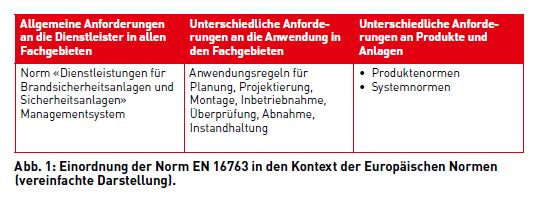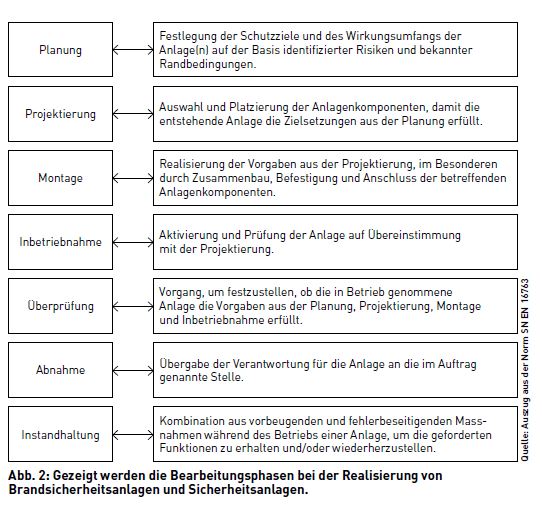Safety installations: Implementation of the European standard in Switzerland
The European standard SN EN 16763 describes minimum requirements for the design, construction and maintenance of safety installations. It contains the clear statement that national laws, regulations and directives apply.

What is the purpose of the European Standard SN EN 16763? It is intended to create a common understanding of a minimum service level by establishing criteria for the performance level of service providers, for the employees involved and for the service result to be delivered.
This European Standard shall be applied together with the rules of application for the field: either European (if any) or national laws and regulations. The standard can serve as a basis for a certification procedure in the respective service field. However, it is not intended to be used alone in a certification procedure.
Submissions and service contracts usually contain extensive descriptions of how and in what quality services are to be provided. EN 16763 defines the process steps from planning to maintenance and the associated terms.
It is very important to take into account the different application guidelines in the specialist areas, which describe the state of the art based on technical standards.
How did the standard come into being?
The basis for a Europe-wide framework in the services sector is the EU Directive 2006/123/EC "Services in the Internal Market", which came into force in 2006. Its aim is to reduce barriers to the cross-border provision of services. Because the European security industry has higher demands on the quality of services, the need for an independent service standard was analyzed by the Service Section of the Euralarm organization and initial proposals were developed. In 2011, work was started by a newly created project committee CEN / CENELEC / TC 0044. Switzerland was significantly involved in the elaboration by the Swiss Standards Association (SNV) and the Swiss delegate of Euralarm.
Special terms for Switzerland
The standard was developed in English and subsequently translated into German and French. In these translations, terms are used that are interpreted linguistically differently in Switzerland than in Germany or France. It was not possible to adapt the translated terms, which is why these terms are explained from a Swiss perspective in the annex to the standard.
The European service standard for fire safety systems and security installations was put into force in Switzerland as SN EN 16763 in April 2017 with a national preface and annex.
In the annex, the different terms that appear in this standard and in the national application rules are assigned. The guidelines drawn up by the SES association are considered to be national application rules.
Structure of the standard
The standard is structured as follows:
- Introduction
- Classification in connection with other standards
- Scope
- Terms
- Requirements
- Appendix A: Guideline for the documentation of the processing phases
- Annex NA: National Annex (Expressions, Application Guidelines)
Terms have been defined for: Authorized representative of the service provider, employees, plant, subcontractor, processing phase, specialist area, service area, service provider, planning, project planning, assembly, commissioning, inspection, acceptance, maintenance, client as well as recognized rule of technology.
Quality requirements
The requirements concerning quality describe the competence, knowledge and experience of the employees who are used for the services. The standard specifies the requirements:
Function A: Employees who represent the service company, who are authorized to make decisions regarding the technical execution and who are responsible for compliance with the relevant standards and regulations in connection with the execution of the order.
Function B: Employees who work independently within the specifications in the service area and supervise the standard work of others, assume some degree of responsibility for evaluating and improving work, are proficient in applicable technical principles and procedures, and can manage risks in the service area according to the requirements of relevant standards and regulations.
Function C: Employees who reliably perform assigned tasks in the service area, assume responsibility for complete task performance, and adapt own problem-solving behavior to circumstances.
In addition, the standard requires requirements for the service result. The service provider must demonstrate processes for defining and documenting work results of a processing phase (cf. Fig. 2 below). The documentation must:
- be structured and appropriate in form,
- be suitable for the intended use of the installed equipment,
- Be complete and comprehensive to support the other processing phases,
- be executed in accordance with the relevant application rules,
- be in compliance with local requirements.
It is also a clear statement that a service company provides documentation in the language commonly spoken at the site of the safety installation or required by the customer.
Likewise, the service provider must organize the technical education and training of its employees and demonstrate their competence.
Specialized training: Other specifications in Switzerland
The standard puts functions A, B, C in context with the European Qualifications Framework (EQF).
A → level 5
B → Level 4
C → Level 3
The EQF is not used in Switzerland. The State Secretariat for Education, Research and Innovation (SERI) has produced a comparative table of Swiss qualification types, which is used to classify Swiss qualifications and diplomas (see Fig. 3 below).
This shows that a federal certificate of proficiency is required for levels 3 and 4 (employee functions C and B). For function A, corresponding to level 5, a qualification with a federal certificate of proficiency is required.
Thus, employees with the following diploma are highly qualified today:
- Project Manager Security Systems with Swiss Federal Diploma
- Fire protection specialist with federal certificate of proficiency
- Fire protection expert with federal diploma
For functions C and B, both the quality certificates issued by the SES (Association of Swiss Installers of Security Systems) and the VKF (Association of Cantonal Fire Insurers) are valid.

Legal, national requirements and the standard
The standard contains a clear statement that national laws, ordinances and directives apply. The Ordinance on Low-Voltage Electrical Installations (NIV) serves as an example here. A company whose employees connect alarm systems to the 230 V mains in Switzerland (non-pluggable connection) must have either a general installation permit according to Art 9 or a connection permit according to Art 14 or 15. The company as the licensee is responsible for ensuring that the employees concerned are registered as licensees in accordance with the procedure specified by the Swiss Federal Inspectorate for Heavy Current Installations.
The NIV applies to installation and maintenance. For installation, it may be acceptable to have the hard-wired electrical connections carried out and measured by an outside company. For maintenance, it becomes problematic if the employee is not a licensee and replaces a part that is subject to the NIV. In this case, this is only permitted if he has completed a recognized course for such work on the respective equipment in the scope of at least 40 lessons of electrical safety. This regulation only applies to companies with a permit and sufficient registered permit holders.
Outlook
SN EN 16763 also permits the certification of individual service phases (cf. Fig. 3). There are too few possibilities for this in practice. Companies operating in Switzerland and their employees are generally certified across all service stages. It makes sense to define individual or selected grouped areas for certification. For professionals dedicated exclusively to planning, it makes little sense to certify other sub-processes.
In a European comparison, Switzerland is in a good position. The main certificates comply with the standard and can be declared accordingly. The Euralarm is currently working out a strategy on how certification according to EN 16763 can be promoted. In this regard, the next step is to identify and list equivalent qualifications of the certification organizations operating in Europe.
* Felix Hahn, former chairman of the SES-Commission "Maintenance" as well as delegate of the SES in the Service Section of the Euralarms.
To which plants does the standard apply?
The standard DIN EN 16763 "Services for fire safety systems and safety installations" applies to
- Fire alarm systems
- stationary fire fighting equipment
- Smoke and heat extraction systems
- Burglary and hold-up alarm systems
- Access control systems
- Video surveillance systems
However, paging systems, alarm receiving centers and security services are not (!) subject to this standard.










